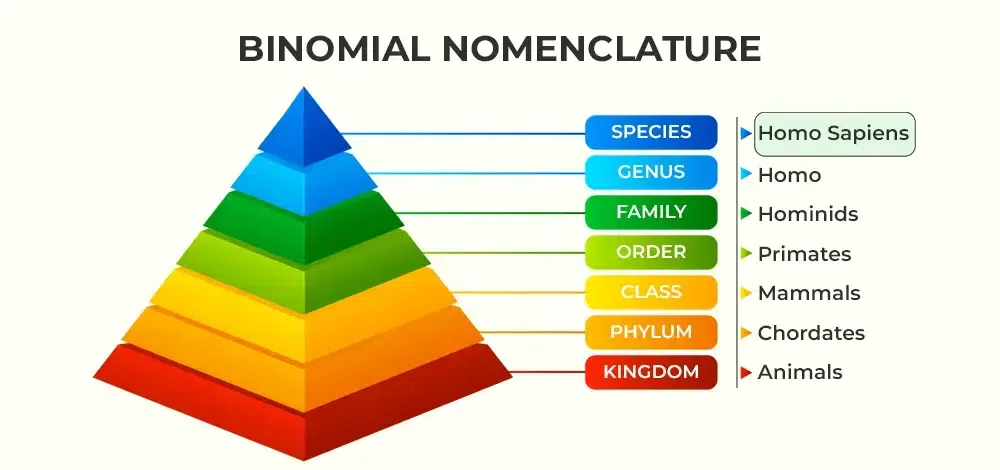Binomial Nomenclature – Definition, Rules, Classification and Examples
Last Updated :
28 Aug, 2023
Binomial Nomenclature is the protocol of naming species in biology using a scientific two-part name, consisting of the genus and the species name. The binomial nomenclature system was introduced by the Swedish botanist Carl Linnaeus in the 18th century and it is still used. Binomial nomenclature is based on the hierarchical classification system known as taxonomy, Nomenclature, in biological classification, is a system of naming organisms.
What is Binomial Nomenclature?
Binomial Nomenclature was given by Carl Linnaues. Different local names are given to specific organisms or plant which make it hard to identify globally. Various names of an organism make a lot of confusion. So to get rid of this confusion scientists came up with this standard protocol. According to this, each organism would have one scientific name. This making process is known as Binomial Nomenclature.
All living species including plants, animals, birds, and some microbes have their scientific names. For eg., The scientific name of the tiger is presented as Panthera tigris. ‘Panthera’ represents the genus and ‘Tigris’ represents a particular species or specific epithet. The scientific name of humans is presented as Homo sapiens. ‘Homo’ represents the genus and ‘sapiens’ represents a particular species.

Rules of Binomial Nomenclature
Today all over the world all scientists follow the same set of taxonomy for naming organisms. 2 different international codes are present which are agreed upon by all scientists all over the world.
- The International Code of Botanical Nomenclature (ICBN): ICBN with the biological nomenclature of plants.
- The International Code of Zoological Nomenclature (ICZN): ICZN with the biological nomenclature of animals.
- both codes make sure that each organism gets a specific name.
- The naming follows certain conventions. Each scientific name has two parts
- Generic name
- Specific epithet
- All the scientific names of organisms are usually Latin. Hence, they are written in italics.
- Two parts to a name of an organism exist. The first word identifies the genus and the second word identifies the species.
- When the names are handwritten, they are underlined or italicized if typed. This is done to specify its Latin origin.
- The name of the genus starts with a capital letter and the name of the species starts with a small letter.
Why is Binomial Nomenclature Important?
There are millions of species of organisms present throughout the world. The same organisms are known by various names around the world and this can confuse when trying to identify or classify them. Binomial nomenclature was seen as a viable solution to this problem.
Drawbacks of Binomial Nomenclature
Following are the primary drawbacks of binomial nomenclature are:
- If two or more names are currently in use, according to the law of priority, the correct name will be the one used first and the others end up being synonyms as validity is the senior synonym. Providing stability in the naming and classification of organisms must be emphasized.
- The names used before those included in the “Systema Naturae”, by Linnaeus are not recognized.
FAQs on Binomial Nomenclature
1. Give one Example of binomial nomenclature?
Answer:
Binominal nomenclature is the system of naming species of living organisms using two words, a genus name followed by a species name. For Example: Magnifera Indica is the Binominal Nomenclature of Mango.
2. Who coined taxonomy?
Answer:
A.P.de Candolle coined taxonomy.
3. What is ‘binomial nomenclature’?
Answer:
Binomial Nomenclature is the system of naming in which the scientific name of an organism has two components, i.e., genus and species.
4. Who is the father of binomial nomenclature?
Answer:
Carl Linnaeus is the father of binomial nomenclature.
Like Article
Suggest improvement
Share your thoughts in the comments
Please Login to comment...